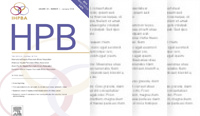International Hepato-Pancreato-Biliary Association
HPB Blog, August 2014

Ask ten surgeons to peel an orange and they will all do it differently and all tell you that their way is best! This adage is tested in the August edition of HPB by a collective of Australian and New Zealand surgeons who have conducted a systematic review looking for consistency in policy for the use of post-operative anticoagulation for patients undergoing portal vein resection and reconstruction as part of a pancreatic resection. This is an important subject and I find that even in my own department opinions on this differ. The study showed that although there was considerable variation in approach to post venous resection anticoagulation the rate of thrombosis was very low unless PTFE grafts were used.
Blood vessels form a bit of a theme for the August issue of HPB with another important paper looking at the thankfully rare situation where the liver is totally de-arterialized in a way in which reconstruction is not possible. Daniel Azoulay’s group from Paris explore this issue in the setting of both liver transplantation and resectional surgery and present a small but important series of patients who have undergone portal vein arterialization in a bid to either bridge the patient to a further liver transplant or to prevent biliary necrosis in the setting of liver resection. Although this surgery is not for the faint hearted this is a must read article for the liver surgeon and a potential “get out of jail” card for the patient.
Mansour University, Egypt have presented an excellent randomized controlled trial of isolated roux-en-Y pancreaticojejunostomy (IRPJ) versus pancreaticogastrostomy in reconstruction of the pancreas after pancreaticoduodenectomy. They found that IRPJ offered earlier return to eating and lower rates of steatorrhoea at one year. A further study from New York identifies a potential link between pancreatic cancer and depression through the kynurenine pathway which is interesting in terms of being potentially druggable and offering improvement in quality of life to patients.
Improving quality of care after surgery is high on most peoples agendas and this issue also contains a systematic review and meta-analysis from my own group on ERAS protocols in liver surgery showing that series that include ERAS principles appear to offer reduced morbidity and length of hospital stay. In addition a study from the Royal Free Hospital in London compares outcomes from liver resection in patients who received either intrathecal morphine plus patient controlled analgesia or epidural analgesia in an effort to further refine and optimize analgesic protocols for patients undergoing liver surgery.
Two articles, one from Hong Kong the other from San Francisco, both advocate aggressive management of hepatocellular carcinoma in different ways and both provide compelling evidence supporting their approaches.
The August edition of HPB continues to present innovative findings and approaches and continues to challenge dogma making it essential reading for all liver and pancreas surgeons.
To view the table of contents of this issue, click here.
Stephen J Wigmore
Corporate Partners
If you are interested in becoming a Corporate Partner of the IHBPA please contact industry@ihpba.org
Find out more


